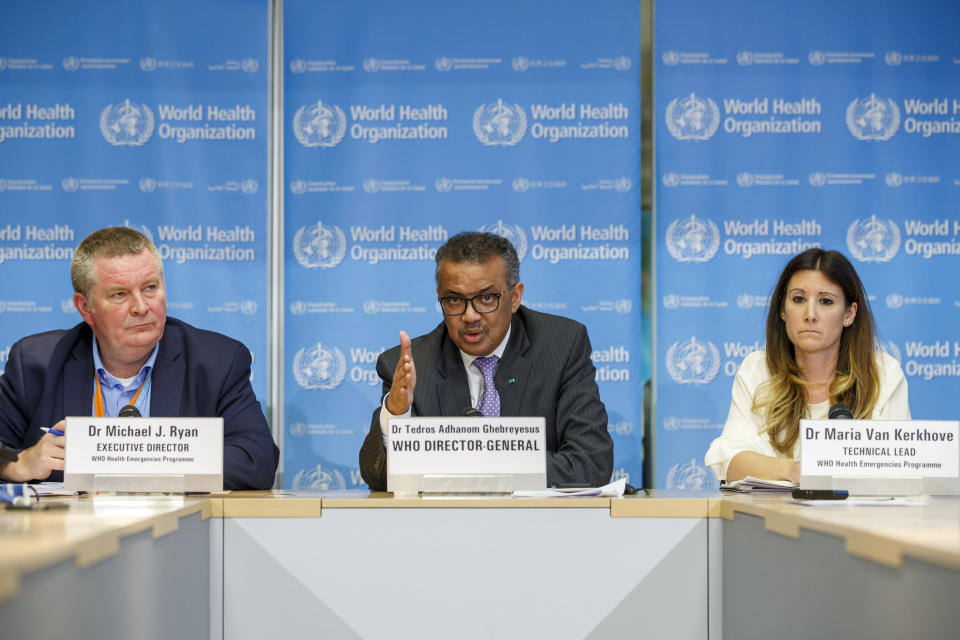WHO walks back statement on 'very rare' asymptomatic spread as infectious disease experts say it is 'not accurate'
The World Health Organization is walking back a statement made by Dr. Maria Van Kerkhove, an infectious disease specialist and the organization’s COVID-19 technical lead, which sparked confusion about how the coronavirus spreads. Van Kerkhove, in a video widely shared on social media, on Monday described the asymptomatic transmission of the virus as “very rare.”
After epidemiologists pushed back on the claim — including the former director of the Centers for Disease Control and Prevention Thomas Frieden — WHO hosted a Q&A on Tuesday morning in which Van Kerkhove clarified the statement. “I was responding to a question at the press conference. I wasn’t stating a policy of WHO or anything like that,” she told reporters. “I used the phrase ‘very rare,’ and I think that that’s [a] misunderstanding to state that asymptomatic transmission globally is very rare. I was referring to a small subset of studies.”
Van Kerkhove went on to note that asymptomatic spread could range from 6 percent to 41 percent, based on the preliminary studies, but that more studies are needed. While the correction has been well received, epidemiologists are still unpacking what led to the claim. Dr. William Schaffner, an infectious disease expert at Vanderbilt University School of Medicine, says that the statement left epidemiologists “scratching their heads” afterward. “We were all confused,” says Schaffner. “What’s clear is that they’ve made things less clear.”

He says WHO’s stating that asymptomatic spread is rare “undercuts” the organization’s earlier messages on the importance of masks. “When you translate science to the real world, you’ve got to adhere to the KISS admonition: keep it simple, stupid,” says Schaffner. “You’ve got to boil it down. If the messages get too nuanced, you create confusion. And that’s exactly what happened. If highly sophisticated infectious disease doctors were confused about the message, you can be sure that John and Jane were also confused.”
So what exactly do we know about asymptomatic spread, and are masks still necessary?
Dr. Megan Ranney, an associate professor in the Department of Emergency Medicine at the Warren Alpert Medical School of Brown University, clarifies. “Based on existing data, it is not accurate to say that asymptomatic spread is ‘very rare,’” says Ranney. “More accurate would be to say: It is difficult to determine what degree of transmission is due to asymptomatic spread.”
In a tweet preceding the WHO statement on Monday, Ranney shared what she now calls the “best current evidence” of asymptomatic spread, a study published in the Annals of Internal Medicine that determined the asymptomatic route of transmission is likely more common than experts realize. In it, researchers analyzed multiple different groups with COVID-19 and found varying levels of asymptomatic individuals. At a Washington state nursing facility, over 52 percent of individuals who tested positive for the virus were initially asymptomatic. Among the more than 3,000 inmates who tested positive for the coronavirus at prisons in Arkansas, North Carolina, Ohio and Virginia, 96 percent had no symptoms at the time of testing.
That last percentage likely includes some who developed symptoms a few days after testing positive — a group now known as presymptomatic individuals. Ranney says it’s important not to miss this significance of this distinction. “From the data I’ve seen, presymptomatic spread is a very, very real thing. We are seeing that people may be most infectious in the 1 to 3 days before they develop symptoms,” says Ranney.
Although differentiating between the two is crucial in the epidemiology world, she says that among the public, where lack of testing makes it near impossible to test those without symptoms, it’s less applicable. Regardless, she hopes that Americans will continue to practice precautions. “At this moment in time, given continued limitations with testing and contact tracing in our country, the best public health practice is wearing a high-quality fabric mask when out in public — to protect yourself and to protect others,” says Ranney.
Dr. Kavita Patel, Yahoo Life’s Medical Contributor, shares this view. “I agree it’s too soon to make this claim now, particularly as we still do not have even surveillance [testing/tracing] across the United States,” says Patel. “We are certainly doing more testing ... but it is still uneven ... we should not make assumptions about the spread.” Patel says that healthy people wearing masks is key. “It is incredibly low risk,” she says. “It doesn’t hurt but could help.”
Schaffner agrees and says WHO should be reasserting that statement as well. “Mask wearing continues to be fundamental as we try to keep the curves flattened and try to reduce transmission of this virus,” says Schaffner. “They’re absolutely critical. And the message is even more important right now in the U.S. because we’re opening up.”
For the latest coronavirus news and updates, follow along at https://news.yahoo.com/coronavirus. According to experts, people over 60 and those who are immunocompromised continue to be the most at risk. If you have questions, please reference the CDC’s and WHO’s resource guides.
How to maintain your physical and mental health during the pandemic
Taking care of a loved one with COVID-19? Here’s how to stay healthy
Q&A with Dr. Kavita Patel: How to keep your family safe and maintain your mental health
Read more from Yahoo Life
How can you keep your pet safe from COVID-19? The CDC issues new guidelines
How to reclaim your sense of joy during the coronavirus crisis
Parenting expert says kids can start doing chores at age 2: 'It's almost never too young'
Want daily lifestyle and wellness news delivered to your inbox? Sign up here for Yahoo Life’s newsletter



